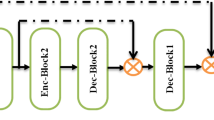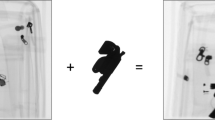Abstract
X-ray baggage screening is a vitally important task to detect all kinds of threat objects at controlled access positions, which can prevent crime and guard personal safety. It is generally performed by screeners to visually determine whether a bag contains threat objects. However, manual detection shows several limitations, from the detection errors to different detection results produced by different screeners. To address these issues, several automated detection approaches have been proposed; nevertheless, none of the methods can achieve end-to-end detection and the results have only classification information without positional information. In this paper, we propose a real-time anchor-free detector of threat objects that can recognize threat objects without using pre-designed anchor boxes. We employ a lightweight but strong backbone network: MobileNetV2 to extract the multi-level information. The backbone network is followed by a deformation layer which aims at handling the nonrigid deformation of threat objects in X-ray images. To further strengthen the proposed network, we design a context enhancement module to aggregate the multi-scale features and generate the enhanced features. We name the network as anchor-free detection network of threat objects (AFTD-Net). We demonstrate the effectiveness of the proposed method against other object detection algorithms on the GDXray database. Our AFTD-Net is a fully convolutional network which does not need any pre-designed anchors and achieves a real-time computation speed of 44.8 FPS.







Similar content being viewed by others
References
Gaus, Y.F.A., Bhowmik, N., Breckon, T.P.: On the use of deep learning for the detection of firearms in X-ray baggage security imagery. In: 2019 IEEE International Symposium on Technologies for Homeland Security (HST), pp. 1–7 (2019). https://doi.org/10.1109/HST47167.2019.9032917
Bayat, A., Nand, A.K., Koh, D.H., Pereira, M., Pomplun, M.: Scene grammar in human and machine recognition of objects and scenes. In: 2018 IEEE/CVF Conference on Computer Vision and Pattern Recognition Workshops (CVPRW), pp. 2073–20737 (2018). https://doi.org/10.1109/CVPRW.2018.00268
Khazaie, V.R., AkhavanPour, A., Ebrahimpour, R.: Occluded visual object recognition using deep conditional generative adversarial nets and feedforward convolutional neural networks. In: 2020 International Conference on Machine Vision and Image Processing (MVIP), pp. 1–6 (2020). https://doi.org/10.1109/MVIP49855.2020.9116887
Tang, S., Roberts, D., Golparvar-Fard, M.: Human-object interaction recognition for automatic construction site safety inspection. Autom. Constr. 120, 103356 (2020). https://doi.org/10.1016/j.autcon.2020.103356
Bicanski, A., Burgess, N.: A computational model of visual recognition memory via grid cells. Curr. Biol. 29(6), 979-990.e4 (2019). https://doi.org/10.1016/j.cub.2019.01.077
Michel, S., Ruiter, J.C.D., Hogervorst, M., Koller, S.M., Schwaninger, A.: Computer-based training increases efficiency in X-ray image interpretation by aviation security screeners. In: IEEE International Carnahan Conference on Security Technology, pp. 201–206 (2007)
Riffo, V., Mery, D.: Automated detection of threat objects using adapted implicit shape model. IEEE Trans. Syst. Man Cybern. Syst. 46(4), 472–482 (2017)
Mery, D., Svec, E., Arias, M.: Object recognition in baggage inspection using adaptive sparse representations of X-ray images. In: Pacific-rim Symposium on Image and Video Technology, pp. 709–720 (2015)
Uroukov, I., Speller, R.: A preliminary approach to intelligent X-ray imaging for baggage inspection at airports. Signal Process. Res. 4(5), 1–11 (2015)
Turcsany, D., Mouton, A., Breckon, T.P.: Improving feature-based object recognition for X-ray baggage security screening using primed visual words. In: IEEE International Conference on Industrial Technology, pp. 1140–1145 (2013)
Bastan, M., Yousefi, M.R., Breuel, T.M.: Visual Words on Baggage X-ray Images. Springer (2011)
Franzel, T., Schmidt, U., Roth, S.: Object Detection in Multi-view X-Ray Images. Springer (2012)
Flitton, G., Breckon, T.P., Megherbi, N.: A comparison of 3D interest point descriptors with application to airport baggage object detection in complex CT imagery. Pattern Recognit. 46(9), 2420–2436 (2013)
Megherbi, N., Han, J., Breckon, T.P., Flitton, G.T.: A comparison of classification approaches for threat detection in CT based baggage screening. In: IEEE International Conference on Image Processing, pp. 3109–3112 (2013)
Mery, D., Svec, E., Arias, M., Riffo, V., Saavedra, J.M., Banerjee, S.: Modern computer vision techniques for X-ray testing in baggage inspection. IEEE Trans. Syst. Man Cybern. Syst. 47(4), 682–692 (2017)
Akcay, S., Kundegorski, M.E., Willcocks, C.G., Breckon, T.P.: Using deep convolutional neural network architectures for object classification and detection within x-ray baggage security imagery. IEEE Trans. Inf. Forensics Secur. 13(9), 2203–2215 (2018). https://doi.org/10.1109/TIFS.2018.2812196
Mery, D., Riffo, V., Zscherpel, U., Mondragón, G., Lillo, I., Zuccar, I., Lobel, H., Carrasco, M.: GDXray: the database of X-ray images for nondestructive testing. J. Nondestruct. Eval. 34(4), 42 (2015)
Redmon, J., Farhadi, A.: YOLOv3: an incremental improvement. arXiv:1804.02767 (2018)
Law, H., Deng, J.: CornerNet: detecting objects as paired keypoints. Int. J. Comput. Vis. 128, 642–656 (2020)
Law, H., Teng, Y., Russakovsky, O., Deng, J.: CornerNet-Lite: efficient keypoint based object detection. arXiv:1904.08900 (2019)
Duan, K., Bai, S., Xie, L., Qi, H., Huang, Q., Tian, Q.: CenterNet: keypoint triplets for object detection. arXiv:1904.08189 (2019)
Newell, A., Yang, K., Deng, J.: Stacked hourglass networks for human pose estimation. In: European Conference on Computer Vision, pp. 483–499 (2016)
Sandler, M., Howard, A., Zhu, M., Zhmoginov, A., Chen, L.: Inverted residuals and linear bottlenecks: mobile networks for classification, detection and segmentation. arXiv:1801.04381v2 (2018)
Lin, T.Y., Dollár, P., Girshick, R., He, K., Hariharan, B., Belongie, S.: Feature pyramid networks for object detection. In: 2017 IEEE Conference on Computer Vision and Pattern Recognition, pp. 2117–2125 (2017)
Jaderberg, M., Simonyan, K., Zisserman, A., Kavukcuoglu, K.: Spatial transformer networks. In: Advances in Neural Information Precessing Systems, pp. 2017–2025 (2015)
Ma, N., Zhang, X., Zheng, H.T., Sun, J.: ShuffleNet V2: practical guidelines for efficient CNN architecture design. In: European Conference on Computer Vision, pp. 122–138 (2018)
Iandola, F.N., Han, S., Moskewicz, M.W., Ashraf, K., Dally, W.J., Keutzer, K.: SqueezeNet: AlexNet-level accuracy with 50x fewer parameters and <0.5MB model size. arXiv:1602.07360 (2016)
Girshick, R.: Fast R-CNN. In: 2015 IEEE Conference on Computer Vision and Pattern Recognition (CVPR), pp. 1440–1448 (2015)
Bodla, N., Singh, B., Chellappa, R., Davis, L.S.: Soft-NMS-improving object detection with one line of code. In: 2017 IEEE International Conference on Computer Vision (ICCV), pp. 5561–5569 (2017)
Paszke, A., Gross, S., Chintala, S., Chanan, G., Yang, E., DeVito, Z., Lin, Z., Desmaison, A., Antiga, L., Lerer, A.: Automatic differentiation in pytorch. In: 31st Conference on Neural Information Processing Systems (NIPS) (2017)
Kingma, D., Ba, J.: Adam: A method for stochastic optimization. arXiv:1412.6980 (2014)
Russakovsky, O., Deng, J., Su, H., Krause, J., Satheesh, S., Ma, S., Huang, Z., Karpathy, A., Khosla, A., Bernstein, M.: Imagenet large scale visual recognition challenge. Int. J. Comput. Vis. 115(3), 211–252 (2014)
Acknowledgements
This research was supported by the National Natural Science Foundation of China (Grant nos. 61977014, 61902056, 61603082), the Fundamental Research Funds for the Central Universities (Grant nos. N2017011, N2017016).
Author information
Authors and Affiliations
Corresponding author
Additional information
Publisher's Note
Springer Nature remains neutral with regard to jurisdictional claims in published maps and institutional affiliations.
Rights and permissions
About this article
Cite this article
Wei, Y., Zhu, Z., Yu, H. et al. AFTD-Net: real-time anchor-free detection network of threat objects for X-ray baggage screening. J Real-Time Image Proc 18, 1343–1356 (2021). https://doi.org/10.1007/s11554-021-01136-5
Received:
Accepted:
Published:
Issue Date:
DOI: https://doi.org/10.1007/s11554-021-01136-5




